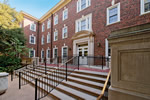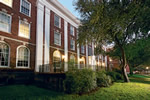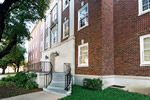
Facilities
Dedman College's 16 academic departments can be found in 10 different buildings.
Each of the buildings offers a story that is critical to SMU's landscape.
View SMU Campus Map »
Dedman College Campus Buildings

Laura Lee Blanton Student Services Building
Known as a "One Stop Shop" where students can take care of administrative issues, the Laura Lee Blanton Student Services Building is a 63,000 square-foot building located on the west side of Airline Road near SMU Boulevard. In addition to housing the University Advising Center, it includes Enrollment Services, Undergraduate Admissions, Financial Aid, Student Financial Services, the Office of the Registrar, Information Technology, the International Center, and SMU-in-Taos.

Carr Collins, Jr. Hall
Home of the Department of Political Science and the John Goodwin Tower Center for Political Studies, Collins Hall was originally known as Lawyers Inn and was a residence for law students. In 1992, as a result of a gift from the Collins family of Dallas, the building was repurposed as a classroom and office building and renamed in honor of Carr Collins, Jr., brother of former Congressman James M. Collins and Dallas civic leader Ruth Collins Sharp Altshuler.

Clements Hall
Dallas Hall and what is today called Clements Hall were the only two permanent buildings on the SMU campus when the University opened in the fall of 1915. Originally it was named the Women’s Building and served as the residence for female students. In the fall of 1926, it became the men’s dormitory and was renamed Atkins Hall. Over 40 years later the facility was renovated again to serve academic purposes. It was renamed in honor of former Texas Governor William P. Clements, whose generosity funded the renovation in recognition of SMU's 50th anniversary. Today, the Office of General Education, Student Records and Academic Services, English as a Second Language, and the University Honors Program, the Embrey Human Rights Program, the Mathematics Department, and World Languages & Literatures Department are located in Clements Hall.

Dallas Hall
For 100 years, SMU's elegant first building has served as a symbol of the University, a standard of its classic collegiate Georgian style, home to intellectual discourse for generations of students and center of SMU’s liberal arts tradition, now Dedman College. Named in honor of the Dallas citizens whose contributions funded the building, Dallas Hall also serves as a symbol of the close relationship the University shares with the city. Originally conceived by Robert S. Hyer, SMU’s first president, Dallas Hall housed all classrooms and laboratories, a library, a snack bar, a post office and faculty and administrative offices. Today, Dallas Hall houses the English Department, the William P. Clements Department of History, the William P. Clements Center for Southwest Studies, the Dedman College Interdisciplinary Institute, and the administrative offices of the Dean of Dedman College.

Dedman Life Sciences Building
Built in 2001 and named after businessman Robert H. Dedman Sr. and his wife, Nancy McMillan Dedman, the Dedman Life Sciences Building is the newest facility in Dedman College and is located in the Science Quad. It houses classrooms, research and teaching labs, computer labs, and faculty offices for the Department of Biological Sciences as well as the offices of the university's pre-health program.

Expressway Tower
In 2006, SMU expanded beyond University Park and Highland Park into the City of Dallas, east of North Central Expressway. Expressway Tower is located in the heart of the new East Campus and is its most notable building, standing 15 stories high. Expressway Tower will house the Department of Psychology from late spring 2013.

Fondren Science Building
Part of Dedman College's Science Quad, this building is home to both the Physics and Chemistry Departments as well as teaching laboratories for the Departments of Biological Sciences and Earth Sciences. Constructed in 1950, Fondren was larger than any other building on campus at the time and had the added benefit of being air-conditioned. In the clock tower is a two-octave carillon with 25 bells, the largest of which weighs four tons. The carillon was gifted by the 1952 graduating class.

Heroy Hall
Another addition to the Science Quad and attached to Fondren Science Building, Heroy Hall hosts the Roy M. Huffington Department of Earth Sciences, the Institute for the Study of Earth and Man, and the Statistical Science, Anthropology, and Sociology departments. Heroy Hall was named after Reverend Newman Lounsberry Heroy, father of William B. Heroy, the founder and first director of the Institute for the Study of Earth and Man.

Hyer Hall
This 1926 structure, named in honor of SMU's first president Robert S. Hyer, was originally designed to house the sciences—Physics on the first floor, Biology on the second and Geology on the third. Relocating these departments from Dallas Hall greatly reduced the crowded conditions in that building. Hyer Hall currently houses the departments of Philosophy, Psychology, and Religious Studies.

Umphrey Lee Center
Built in 1955 and named in honor of SMU's fourth president and then chancellor, the Umphrey Lee Center was originally utilized as a student center. It currently houses the Economics Department, which offers some of Dedman College's most popular degree programs, and the Richard B. Johnson Center for Economic Studies.